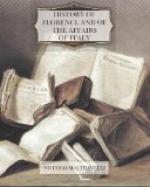Still no definite arrangement was made; but it was resolved that Giovanni Batista and Francesco de’ Pazzi should go to Rome and settle everything with the pontiff. The matter was again debated at Rome; and at length it was concluded that besides an expedition against Montone, Giovan Francesco da Tolentino, a leader of the papal troops, should go into Romagna, and Lorenzo da Castello to the Val di Tavere; that each, with the forces of the country, should hold himself in readiness to perform the commands of the archbishop de’ Salviati and Francesco de Pazzi, both of whom were to come to Florence, and provide for the execution of their design, with the assistance of Giovanni Batista da Montesecco. King Ferrando promised, by his ambassador, to contribute all in his power to the success of their undertaking. Francesco de’ Pazzi and the archbishop having arrived at Florence, prevailed upon Jacopo di Poggio, a well educated youth, but ambitious and very desirous of change, to join them, and two others, each of the name of Jacopo Salviati, one a brother, the other a kinsman, of the archbishop. They also gained over Bernardo Bandini and Napoleone Franzeni, two bold young men, under great obligations to the family of the Pazzi. Besides those already mentioned, they were joined by Antonio da Volterra and a priest named Stefano, who taught Latin to the daughter of Jacopo de’ Pazzi. Rinato de’ Pazzi, a grave and prudent man, being quite aware of the evils resulting from such undertakings, refused all participation in the conspiracy; he held it in abhorrence, and as much as possible, without betraying his kinsmen, endeavored to counteract it.
The pope had sent Raffaello di Riario, a nephew of Count Girolamo, to the college of Pisa, to study canon law, and while there, had advanced him to the dignity of a cardinal. The conspirators determined to bring this cardinal to Florence, as they would thus be better able to conceal their design, since any persons requisite to be introduced into the city might easily be made to appear as a part of his retinue, and his arrival might facilitate the completion of their enterprise. The cardinal came, and was received by Jacopo de’ Pazzi at his villa of Montughi, near Florence. By his means it was also intended to bring together Giuliano and Lorenzo, and whenever this happened, to put them both to death. They therefore invited them to meet the cardinal at their villa of Fiesole; but Giuliano, either intentionally or through some preventing cause, did not attend; and this design having failed, they thought that if asked to an entertainment at Florence, both brothers would certainly be present. With this intention they appointed Sunday, the twenty-sixth of April, 1478, to give a great feast; and, resolving to assassinate them at table, the conspirators met on the Saturday evening to arrange all proceedings for the following day. In the morning it was intimated to Francesco that Giuliano would be absent; on which the conspirators




